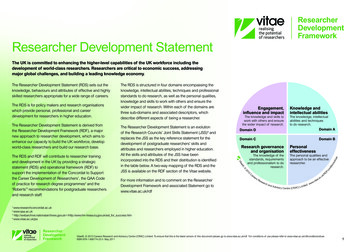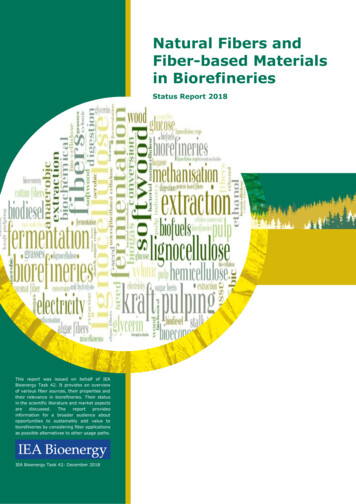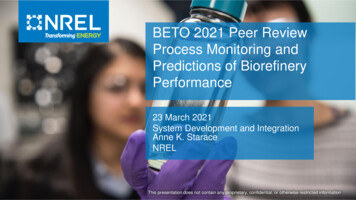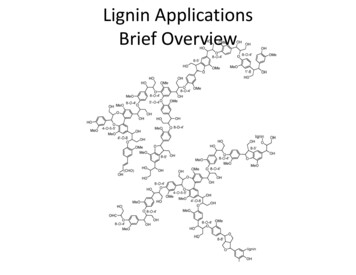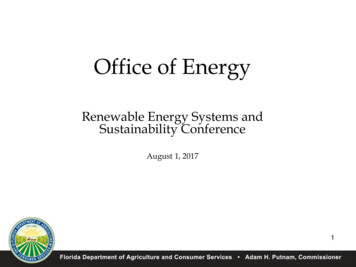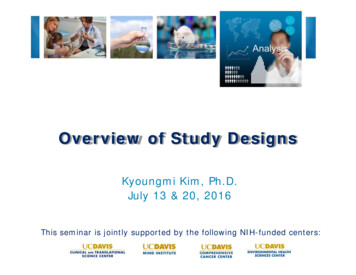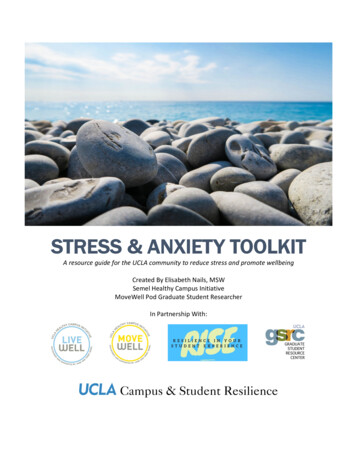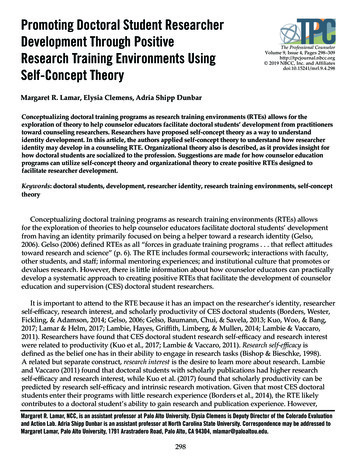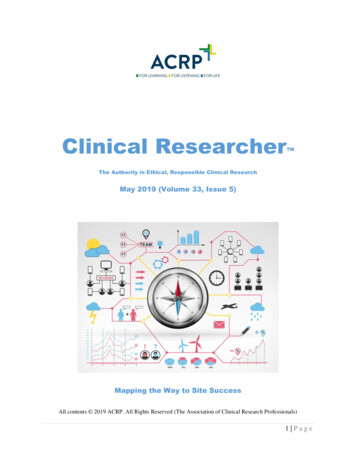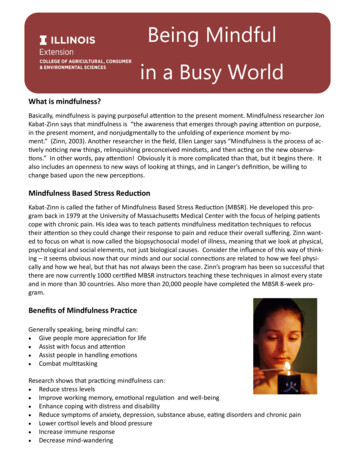
Transcription
BiorefineryResearcher2IssueJune 2009In collaboration with SUSTOIL and BIOREF-INTEG, 2 Support Action projects funded by theEuropean Commission through the Seventh Framework Programme (June 2008—May 2010)Contents:IntroductionPage 2BIOREF-INTEG PartnersPage 13SUSTOIL WorkshopPages 3-6BIOREF-INTEG ProgressPages 14-15SUSTOIL WP5 & 6Pages 7-8BIOREF-INTEG Biorefinery Pages 16-25related articlesSUSTOIL NewsPages 9-11General InformationPage 26SUSTOIL PartnersPage 12EventsPage 27ContactPage 28
IntroductionThe biorefinery conceptinscribes within the widestcontext of the fight againstglobal warming and EUenergy security. It willcontribute to the ambitiousobjectives stated in the EUenergy & climate changepackage by developingprocesses which are able toincrease efficiency andenhance sustainability ofbiofuel & bioenergyproduction.answer to a lot of prayers inmany different policy areas.That is why the EC sees it asone of the most promisingresearch topics and has put ithigh in the agenda. BIOREFINTEG and SUSTOIL are twopioneering, prospectiveprojects in this domain, to befollowed soon by manyothers, when a specificBiorefinery call - launched inSeptember 2008 - delivers itsresults.Moreover, biorefineries willcontribute to other importantEU objectives, such asincreasing industrialcompetitiveness, creatingnew opportunities foragriculture and rural areas, orpermitting the valorisation ofdifferent organic wastes.Future biorefineries will mostlikely be developed fromexisting industries (sugar/starch ethanol plants, oilseed crushing /trans-esterification plants,pulp and paper mills, etc.),by optimisation of sidestreams, or by combination ofexisting processes. Hence the José Ruiz Espiimportance of identifyingEC Project Officer,schemes with the highestEuropean CommissionTherefore, the biorefineryconcept seems to be thePage 2potential to be integrated intocompetitive biorefineries. Nodoubt the conclusions ofSUSTOIL and BIOREF-INTEGwill be of high interest to thescientific and industrialcommunity.SUSTOIL and BIOREF-INTEGstarted on 1st June 2008, andis due to finish by May 2010.As both projects deal with thesame topic, the informationgenerated within each one iscertainly of high interest tothe other. In order to ensurethat this cross-fertilizationtakes place, the EC hasrequested that a number ofjoint activities is organised.This joint newsletter is animportant contributiontowards this.
Developing advanced biorefinery schemes to convertwhole EU oil-rich crops into energy, food andbioproducts. This will make optimal use of the sidestreams generated during farming/harvesting, primaryprocessing and secondary processing.Green Chemistry Centre of Excellence,University of YorkDr Abbas KazmiSustoil Project ManagerEmail: ak584@york.ac.ukTel: 44 (0)1904 434549Tel: 44 (0)1904 434549Fax: 44(0)1904 432705Email: info@sustoil.orgwww.sustoil.orgPage 3June 2008—May 2010Professor Ray MarriottSustoil Co-ordinatorEmail: rm555@york.ac.ukTel: 44(0)1904 434478
SUSTOIL holds its First WorkshopSustoil: Developing advancedBiorefinery schemes forintegration into existing oilproduction/transesterificationplants. Writer: Dr Abbas Kazmi,Sustoil Project Manager,ak584@york.ac.ukunspoilt coastal areas. On thesecond day of the workshop theconsortium visited a lagoonarea where large volumes ofGracilaria macro-algae can beharvested and the Sustoilpartners have been requestedby the local government to findapplications for the Gracilaria.Overall this region has greatpotential for development andgrowth.utilisation of by-products. Theyield of oilseed rape can beincreased by selectivebreeding, genetic manipulationand improving cropmanagement practice. Withoptimised conditions high yieldsof up to 6.5tonnes/ha can beThe Sustoil project which isobtained which is considerablycoordinated by the Universityhigherof York held its first workshopthan the current average EUin Foggia, south Italy on theyields of 3.5 tonnes/ha. The24th of April 2009. As asunflower crop is mainlycoordination support actionThe first workshop day started affected by water and nutrientproject it involves 23 partnerswith a welcome by Antonioavailability therefore yields canfrom 10 EU countries. ThePepe, the president of thebe improved by matching theworkshop was arranged forFoggia region and was followed cultivar with the waterthree technical work packagesby Dr Pasquale Pazienzaavailability, replacing waterto disseminate their findings to representing the University ofdemanding crops withthe consortium.Foggia, a Sustoil partner andsunflower and making sure(pictured above).the workshop hosts. After anfarmers conform tointroduction by Professor James recommended practices. TheThe region of Foggia has veryClark and an update byby-products of these cropsfertile land producing oranges, Professor Ray Marriott the first include the straw, stalk and thelemons, olives, almonds,work package participantsleaves which can containdurum wheat, grapes andcommenced with theirnumerous valuable chemicalsmany other agriculturalpresentations.such as hydrocarbons, waxproducts on a large scale. Byesters, aldehydes, ketones,utilising its biomass, the region Work package 1:alcohols and acids. The yieldshas potential to develop as aOptimisation of oil cropsof these components is only 0.3bioeconomy which could helpagronomy and oil yield, and -2% and the main extractionreduce the unemployment rate utilisation of by-productsmedium (supercritical CO2) isof 30%. As well as having largeexpensive therefore furtherareas of arable land, FoggiaWork package one involvesresearch is required. Otherhas beautiful mountainousoptimisation of oil cropschemicals such as methane andlandscapes and breathtakingagronomy and oil yield, andlevulinic acid can be obtainedPage 4
from by-products usinganaerobic digestion and greenchemistry methods.focused on optimisation of oilrich crop primary processing i.e.the extraction of oil. The ‗hull‘ isan outer layer of seeds and byAlternatively the by-products can removing this, the proteinbe pelletised and used as a direct content of the cake mealfuel for energy production. Thesignificantly improves. The hullspelletisation process is also a pre can be pelletised and used as a-treatment method forfuel as they have a high burningsupercritical CO2 extraction andvalue of 8,100 BTU/Ib. The highanaerobic digestion. The strawsburning value is partly attributedcan contain large amounts ofto the 3% of oil which ispectin and can also be used as a removed with the hulls duringfeedstock for producing variousthe dehulling process. Thereforetypes of materials such asremoval of residual oil throughbiosorbents, paper andthe use of clean technologiesparticle boards.such as supercritical CO2extraction and microwaveThe contributors to this workprocessing is important. The oilpackage are Alain Quinsacrefining process leaves behind(CETIOM), Francis Flanetfree fatty acids (as soap stock),(CETIOM), David Turley (FERA), pigments, phosphotides, soaps,Ruth Leybourne (FERA), Raymetals, phytosterol andMarriott (University of York), K.tocopherol.Stamatelatou (FORTH), BirgittKamm (Biorefinery.de), AntoineSome of these fractions can beRouilly (INPT) pictured below.converted into biodiesel andothers can be used in the foodWork package 2:additive, pharmaceutical andOptimisation of oil-rich cropcosmetics industries. Rapeseedprimary processing i.e. theoil is mainly used for edibleextraction of oilpurposes and the rape meal thatis left behind is used as a proteinThe second work package-rich animal feed additive. LargerPage 5amounts of rape meal additivecannot be used as it containscertain anti-nutritionalsubstances. Therefore valuableextractives from rape meal havebeen identified such as bioactiveproteins, biocidal, pesticidal andantioxidant compounds. Afterolive oil extraction the pulp canbe valorised via anaerobicdigestion to producehigh yields of methane andhydrogen. The rapeseed andsunflower cakes have beenshown to be promising rawmaterials for material productionvia thermo-mechanicalprocessing due to the presenceof lignocellulosic fibres.The resulting materials exhibitnatural resistance to water andthe economics of the process aregood. Further work needs to beconducted on removing the highlevels of amino acids withinsunflower and rapeseed and thecellulose content could beconverted into Levulinic acid orethanol.The contributors to this workpackage are Patrick Carre(Creol), Camelia Echim
toil/Pages/rotawave.htm(University of Ghent), WimMulder (AFI), David Turley(FERA), Antoine Rouilly (INPT),Birgit Kamm (biorefinery.de)Work package 3:Optimisation of secondaryprocessing i.e. biodieselproductionThe third and final workpackage of this workshop wasregarding the optimisation ofsecondary processing i.e.biodiesel production. Clearly inorder to make such biofuelscompetitive with mineralderived fuels it is necessary tovalorise any waste streams.Glycerol is a by-product ofbiodiesel production and cancost companies significantamounts to dispose of. Howeverthere are a number of uses ofthis by-product and whensimply purified the cleanglycerol can have saleablevalue. Glycerol can also be usedas a chemical building block toproduce an array of chemicalssuch as propylene glycol,triacetin and succinic acid viachemical or biochemical routes.Glycerol can also be used toproduce additives for theproduction of wood panels.Interestingly, novel routes tobiodiesel have been identifiedwhich do not produce anyglycerol by-product and arecurrently being commercialisedby some of the Sustoil partners(UCO & Seneca).The contributors to this workpackage are Rafa Luque (UCO &Seneca), Zsanett Herceski(UoP), Abbas Kazmi (UoY), IliasKatsampas (Chimar Hellas)pictured above.The next stage of the projectwill ascertain the sustainabilityof the various developedschemes outlined in the firstthree work packages through afull life cycle assessment andcomputational modelling of theeconomic, social andenvironmental costs andbenefits. Furthermore variouspolicy scenarios will bedeveloped to understand anypotential environmental,economic and policy constraintsthe bioenergy and biorefinerysector could face within asustainable developmentframework.Detailed reports on each of thework packages are available onthe Sustoil websitehttp://www.sustoil.orgPage 6
Work Package 5: Social, environmentaland economic cost-benefits analysisof biorefinery schemesThe objective of this work packageis to construct integrated models ofbiorefinery plants starting from theraw material and combining theproduction of biofuels with theprocessing of waste streams,including a multitude of options:from purification and separation tothe production of platform chemicalsand bioplastics.The LCA investigations will be basedon appropriate databases, mostlybased on European studies, sincewe are obviously interested indeveloping an EC-relevant analysis.The results from LCA will be used toalso evaluate upstream options,such as land use, transportation ofraw materials and carbon footprinting of the reviewed schemes.Different oilseeds will be taken intoaccount as raw materials and theirviability for the production of fuelsand chemicals will be explored. Tothis effect, we have alreadyconstructed a simulator based on acommercial package together withhome-made codes for the modellingof a plant, which includes the oilextraction from seeds, the chemicalproduction of biodiesel and thebiochemical processing of glycerol,the main by-product from biodieselproduction, to obtain platformchemicals.We are planning to combine LCAwith optimization techniques, todevelop holistic biorefineryevaluations that satisfy combinedsocio-economic and environmentalobjectives. Our aim is to producequantifiable multi-objectivecomparisons of biorefinerystrategies that will providecomprehensive directions for thefuture.The model has been validated withboth literature and experimentaldata.In the second year of SUSTOIL, weare planning to simulate a numberof biorefineries, considering theoptions reviewed in work packages1-4 and to compare the viability ofthe different designs througheconomic analysis, including rawmaterials costs, capital costs andup-to-date product prices.Furthermore, the work from thispackage is naturally coupled withthe objectives of work package 6,which is concerned with theinterplay between governmentalpolicies, economic andenvironmental impacts.Work package leader:Dr. Constantinos Theodoropoulos,University of Tel: 44 161 306 4386The environmental impact of thesedesigns will also be taken intoaccount from a waste minimizationand emissions reduction point ofview. Life Cycle Analysis (LCA)studies will then be employed toassess not only the environmental,but also the social impact of theschemes that the modelling studieswill indicate as viable.Page 7
WP6: Modelling stakeholder interplayand policy scenarios for biorefineryand biodiesel production – a briefoutline for activities in 2010In 2010, the main activities forWP6 will be the following:reductions and trade acrosscountries according to thefollowing three main scenarios:In February, during the plannedworkshop II, the findings of the1)multi-country CGE model for theEU, based on the work by the UoYand the findings of the socialnetwork model, based on the workby the UoF, will be illustrated.2)3)A change in technology tocomply with the EuropeanCouncil independentcommitments of renewableenergy use post-2012agreements.The implementation ofdifferent tax (or subsidy)rates on energy inputs andon emissions, at eithernational or EU harmonisedlevel.A change in land-use ifbiodiesel is considered asinput to production.Social network model:The objective of this model istwofold:The details are briefly explained inthe notes below:Multi-country CGE model forthe EU:This model aims at representingpolicy scenario for biorefineryschemes in the EU and itssubsequent effects on consumerwelfare across EU member states.The model is built-up to representeconomic, environmental andtrade interactions across amultitude of agents such ashouseholds, firms andgovernments. The model‘s basecase considers current technologyof energy and biofuels inputs toproduction (based on informationretrieved through the work of WPs1-3), biodiesel consumption fromhouseholds and governments,local and trans-boundary pollutionemissions.The model‘s policy simulation willconsider the effects on consumerwelfare and on the economicstructure of a country, emissionsTo understand the extent towhich various environmental,economic and policyconstrains prevent biofuel andbiorefinery energy fromemerging as a newtechnological regime.To develop, through theanalysis of heterogeneousagents interactions at macro,meso and micro levels,various policy scenarios andpolicy prescriptionscompatible with a sustainabledevelopment approach.using network data gathered bymeans of a questionnairedistributed in May-June 2009 tovarious stakeholders in theprovince of Foggia (Capitanata,Italy) and designed to collect datafor the analysis of the preconditions of technologicalchange. Specifically, three mainsocial mechanisms will beinvestigated. These are theconvergence of actors‘expectations towards a commonview, the inclusion in the networkof powerful actors with theirresources, and the occurrence ofeffective learning interactionsamong agents in the niche. Then,various social network indicatorswill be used to provide asystematic analysis of thenetwork. The data gathered willalso offer the base to calibrate theagent based model directed toanalyze the various stakeholders‘interplay scenarios.Finally, by May 2010, a finalreport of the two modelsexplaining stakeholders interplayand policy scenarios forbiorefinery and biodieselproduction based on the feedbackof participants in workshop II andfuture research suggestions will beprovided.Dr Caterina DeLuciaIn order to do so, a specifictheoretical framework is adopted,namely the multi-level approach.This approach sees technologicaltransitions as the outcomes ofsocial-economic interplay withindedicated networks of actorscommitted to technologicalchange.Research Fellowin EnvironmentalEconomics,University of York,UKDepartment ofEconomics, University of Foggia,ItalyDepartment of Planning,Technical University of Bari,ItalyThe social network methodologyallows to study such interactionmore in depth. This will be doneE-mail: cdl103@york.ac.ukPage 8
Foggia, South Italy – A hotspot forinvestmentFigure 1: Some of the Sustoil partners visiting the beautiful Foggia coastItaly is world renowned for itswine which is grown in the south,and in such fertile land it is notsurprising that a wide range ofother high quality produce such asolives, oranges, almonds anddurum wheat are produced. Inparticular, the Foggia region hasoptimal conditions for biomassgrowth and has the potential tofurther develop its bio-economy.Clearly with a region producingvast quantities of food it isimportant that any developmenthas to be done in a sustainablemanner. An issue which has beenhighlighted in south Asia is thedamaging effect of indirect landuse. When a unit of land which isnot used for food growth isdeveloped for biofuel crops suchas Palm then it is quite likely thatnearby forests or food crops willbe deprived of some fresh water.This needs to be avoided,however, there are no strictinternational policies enforcing thiscurrently.The utilisation of non-foodbiomass removes many of theissues discussed above—howeverit is important to know that aFigure 2: Foggia Coastlarge percentage of food producedin the EU goes to land fill. Foggiabeing a large food producermeans there will be significantamounts of agricultural residuessuch as olive stones and wastestraws. Foggia also has a largelagoon area where macro-algae(Gracilaria) is being harvested andthe local government isencouraging novel biorefineryuses for this area.The olive stone can be used as arenewable solid biofuel togenerate electricity. The stonescan be co-fired with fossil fuelssuch as coal and burned in powerstations. A large power station(Drax) in the UK is currently cofiring palm kernels and oliveresidues to generate electricity.The alternative is to set up smallbiomass boilers which will burnthe olive stones to generateelectricity for a small number offarms and factories. Thesetechnologies exist today andtherefore can be deployedrelatively quickly. However marketinformation is required on howmuch olive stone waste exists inthe region and what its currentuse is.Much research has beenconducted on conventional wheatstraw and there is an opportunityfor researchers to conduct similarstudies on durum wheat. Thestraw has potential to be used asa solid biofuel to generateelectricity and due to its highcellulose content it could be usedto produce biofuels or chemicals inthe future.Macro algae such as Graciliariacan be abundantly grown in theFoggia lagoon and is a promisingfeedstock for anaerobic digestionas shown by an EPOBIO reportpublished in 2007 (http://www.epobio.net/news/news070917.htm). The resultingmethane gas could supply energyto the region. Further work isrequired to identify how muchmacro-algae can be grownseasonally in the lagoon and thepotential methane yield. Furtherstudies on the economics andinitial capital costs need to beconducted.The region of Foggia is generally isunder-developed and there ispotential for significant growth.With unemployment at around30% the government will backinitiatives for revenue generationand job growth.The availability of durum wheatstraw and potential quantitiesneed to be known to assist thedevelopment of this resource.Wheat straw can be processedinto useful products such as paper For further info contact:and boards. Furthermore it canDr Abbas Kazmicontain valuable waxes which are Email: ak584@york.ac.ukused in the cosmeticsindustry.Page 9
Biomass Companies on the StockExchangeAcademics have the primaryambition to generate world-classresearch and publish their work inpeer-reviewed journals. Howeverin projects such as Sustoil whereacademics work closely with largeindustrial companies such asCRODA, the target is not alwaysto publish work. Many universitiesand institutes in the world, suchas MIT believe that researchshould be focused oncommercialisation. Indeed manyof the technological advancementswe observe in society today aredue to such research. A novelcommercial product can make theinventors very wealthy andincrease their reputation within auniversity or research community.The Sustoil project has identifiedmany research areas which couldlead to commercial development.More information on thesedevelopments can be found on theSustoil website. When aresearcher has identified ordeveloped a new product then thefirst step tends to be a patent.This secures the researcher‘sintellectual property and theproduct can be licensed tocompanies which in return payroyalties. When a product requiresconstant R&D support and iscapital intensive to start-up, manyresearchers source capital frominvestors. Investors have arigorous approach to whichcompanies to invest in and cantake a considerable chunk of theownership. If a company requiresfurther capital then listing on astock exchange can be a goodmove. Institutional or retailinvestors buy shares on the stockexchanges and pick companiesbased on several criteria. Theseinclude potential growth forecasts,price to earnings ratios, dividendyields, discounted cash flows,share price performance andsenior management quality.projects using biogas, natural gas,bio-oil, woody biomass andsecondary fuels. The companycreates value for its partners andshareholders as a one-stopprovider of sustainable energysolutions, converting biomass intoelectricity and heat. The companyhas an integrated approach andhelps clients from initial conceptdesign through to the final sellingof electricity. The growth in thecompany is reflected by theincrease in the number ofemployees from 13 in 2006 to 176in 2008.One such company is calledThenergo (http://www.thenergo.eu/) which is listedon the Euronext Brussels stockexchange. Thenergo is anindependent developer andoperator of sustainable energyFor further information pleasecontact:There are many other companieson stock exchanges throughoutthe world creating wealth frombiorefinery principles. Moreinformation will be available in thenext newsletter.Dr Abbas Kazmi,ak584@york.ac.ukSustoil: A lasting legacy?Many EU projects last for a fewyears and during that periodproduce high quality researchwhich has to be disseminatedwidely through websites,conferences and publications.Presentations and stands atconferences distribute theknowledge to a wide scientificcommunity - however theseevents only last for a few daysthe project. We hope to haveand the delegates may not be able some good news on this subject into absorb the information fully.the next newsletter. If you areinterested in contributing to aPublications in an EU project canbook on EU oil-rich plant oils theneffectively disseminate parts ofplease contact:the research, but the integratedresearch approach may not beDr Abbas Kazmieffectively transmitted. It seemsak584@york.ac.uk.that the best approach for suchprojects may be the publication ofa book by a respectable publishingcompany.The Sustoil management teamhave received an offer from aworld renowned publishingcompany to use some of theSustoil results to write a worldclass book. This will ensure thatmost of the results are availablefor a long time after the end ofPage 10
Featured AdvisorProfessor Dermot J Roddy,CEng, FIETDermot Roddy joined Newcastle Universityas Science City Professor of Energy in2008 after a period of some 20 years inthe energy industry and petrochemicalsectors. He is also Director of the SirJoseph Swan Institute for EnergyResearch, which integrates energyresearch across Newcastle University andlinks with a powerful external industrialbase in the energy sector.Outside of the university he is Chairman ofNorth East Biofuels, Finance Director ofthe UK Hydrogen Association and VicePresident of the Northern EnglandElectricity Supply Companies Association.Prior to coming to Newcastle University hewas Chief Executive of Renew Tees ValleyLtd – a company which he set up in 2003to create a viable and vibrant economy inthe Tees Valley based on renewableenergy and recycling – where he wasinstrumental in a wide range of majorrenewable energy and low-carbon projectsrelating to biomass, biofuels,hydrogen, carbon capture & storage, windand advanced waste processingtechnologies. From 1998 to 2002 he ranthe crude oil refinery on Teesside as sitedirector for a 5 bn-turnover facilitybefore moving to the Netherlands to workon Petroplus‘ international growth plans.Dermot‘s experience in the petrochemicalindustry began in 1985, involving a varietyof UK and international roles in operations,engineering and technology with ICI andothers. Prior to that he developed leadingedge technology at Queen‘s University,Belfast, for optimisation and control inaerospace applications.SUSTOIL Web SiteThe SUSTOIL website can be found at:www.sustoil.orgHere you will be able to find adefinitive overview of SUSTOIL and itsobjectives.Other useful information includes avariety of publications, the latest news,details about forthcoming events, aswell as links to other biorefineryprojects.Statistics to Date:Total Visits: 3,155Total Page Views: 17,625Our dedicated intranet system for allproject partners is also live. Please signyourself up to take full advantage ofthis service - www.york.ac.uk/res/sustoil/Pages/Login.htmlPage 11
SUSTOIL PartnersSUSTOIL will integrate theexpertise of 23 project partnerswith the expertise of an AdvisoryBoard composed of experts fromthe EU, US and beyond.Economic, social andenvironmental costs benefits ofoptimal integrated schemes willbe assessed and maintechnological challenges/knowledge gaps will be identified.Resulting in recommendations ofkey activities for futurecollaborative projects.The map below shows where thepartners are located-DTUAFIBiorefinery.deUGentCJ CETIOMCreolINPTSenecaUCOUoFNECUPOur Partners1.2.Agricultural University ofAthens, GreeceCroda International PLC,UK18.University of Foggia, Italy11.FORTH, Greece19.University of Ghent,Belgium12.INP Toulouse, France20.University of Manchester,UK13.Nógrádi Erdökémia Co,Hungary21.University of Pannonia,Hungary22.University of York(Coordinator), UK23.Agrotechnology andFood Innovations BV,The NetherlandsBioCentrum-DTU, Denmark3.Biolea, Greece4.Biorefinery.de GMBH,Germany5.10.Central ScienceLaboratory, UK14.Rotawave Ltd, UK6.CETIOM, France15.Seneca Green Catalyst SL,Spain7.Charles Jackson & Co Ltd,UK16.Stockholm EnvironmentInstitute, UK17.University of Cordoba,Spain8.Chimar Hellas SA, Greece9.Creol, FrancePage 12
Project CoordinatorIr. H. MozaffarianTel: 31 224 56 42 62Email: mozaffarian@ecn.nlProject Web Sitewww.bioref-integ.euDevelopment of Advanced BIOREFinery Schemes to beINTEGrated into Existing Industrial Fuel ComplexesJune 2008 - May 2010BIOREF-INTEG PartnersGhent University,Gent, BelgiumECN,The NetherlandsEnergy and Mill Systems,INNVENTIA AB,Stockholm, SwedenVTT,FinlandAston University,UKETC,SwedenAFSG,The NetherlandsCentro do TechnologiaRepsol YPF S.A.Madrid, SpainCehave,TheNetherlandsAbengoa,SpainBioro NV,BelgiumPage 13VFT,BelgiumTen Kate,The Netherlands
BIOREF-INTEG ProgressAn introduction fromHamid Mozaffarian,BIOREF-INTEGCoordinatorThe first issue of ‗BiorefineryResearcher‘ focused onpresenting the BIOREF-INTEGConsortium, the projectobjectives and its workpackages. This second issue willbegin with a brief presentationof the progress achieved perwork package during the firstyear of the project. After that, asummary will be presented ofthe first project workshop heldat the beginning of this year inOsnabrück, Germany. Thenthree articles will followregarding the activities of someof the project partners (TenKate, Bioro, Ghent Universityand AFSG) in the field ofbiorefinery.Also three biorefinery-relatedprojects, with participation of anumber of project partners(VTT, AFSG, Ghent Universityand ECN), will be presented:one ongoing (Biocoup) and tworecently concluded (Biopoland Biorefinery Euroview).Work package 1Work package 2rapeseed, pulp/paper residues,food industry residues and agroFor each of the seven biomassA literature analysis has beenresidues. Also a literature andrelated market sectors (see figure conducted within the field ofweb-analysis on current marketbelow), the existing industrialbiomass-derived products inprices and volumes of the(fuel producing) complexes fororder to identify current andmaterials and chemicals identifiedthe six partner-related countriespotential materials and(Finland, Sweden, UK, Belgium,chemicals. The analysis has been is ongoing. The longer-termpotential market developmentsSpain and the Netherlands) have based on the composition of theaffecting directly the futurebeen identified. Based on theraw materials of the selectedmarket volume demand andachieved results, at least onereference cases within WP1, i.e.market price of these productsreference case per market sector wood, straw, sugar beet, wheat,will also be roughly assessed.has been defined as a realisticpotatoes, grass, micro-algae,representative of the sector.WP7 (ECN)The reference cases areProject managementbriefly described, including ablock diagram with mainWP2 (Aston)WP1 (ECN)WP3 (A&F)overall mass and energyIdentification and marketIdentification and mappingBiorefinery-based knowledgeanalysis of most promisingofexistingindustrialfuelbalances. The referenceimport from outside the ECadded-value productsproducing complexes in Europeto be co-produced with fuelscases will be evaluated inWP4, where they will also beWP4 (VTT)upgraded to high efficiencyTechno-economic and ecological assessment of biorefinery concepts integrated into existing industrial complexesBioethanolBiodieselPulp/paperOil
processing i.e. biodiesel production The third and final work package of this workshop was regarding the optimisation of secondary processing i.e. biodiesel production. Clearly in order to make such biofuels competitive with mineral derived fuels it is necessary to valorise any waste streams. Glycerol is a by-product of biodiesel production and can

